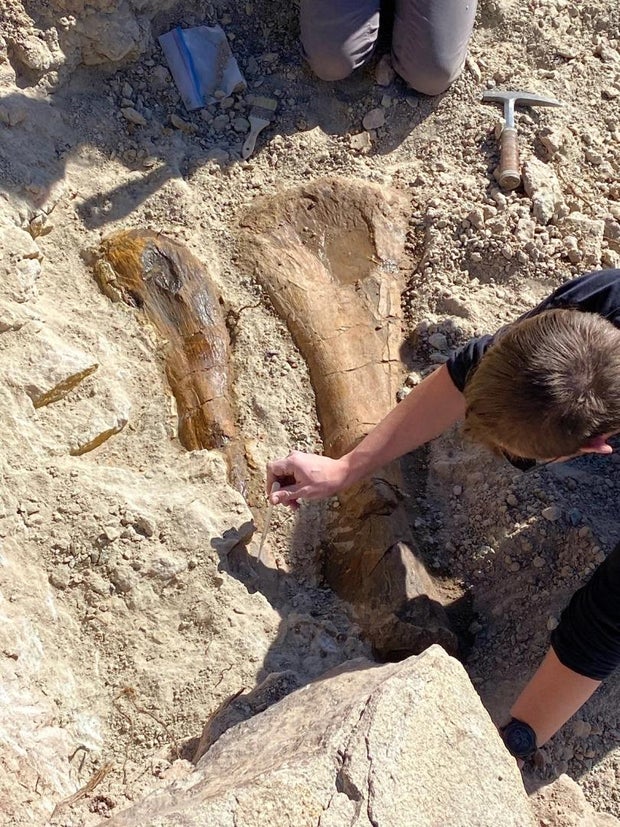An excavation team in southern Colorado has unearthed two dinosaur fossils. They belong to a longneck sauropod dinosaur, according to the Royal Gorge Regional Museum & History Center in Cañon City.
The museum will be presenting the fossils to the public later this month. It shared the news this week in a Facebook post explaining that the bones are a tibia and a fibula. The discovery was originally made by someone who “stumbled on” one of the fossils and reported the find to the Bureau of Land Management. So far it hasn’t been revealed exactly where the bones were found but it is presumably in Fremont County.

Sauropods are plant-eating, four-legged dinosaurs with long necks and tails.

The excavation team was put together by the museum, the BLM and the Denver Museum of Nature and Science.
After the fossils are revealed to the public on Jan. 21, museum staff and members of the Western Interior Paleontological Society will be working to prepare and preserve them in the museum’s program room. Visitors to the museum will be able to “observe our trained volunteers in action prepping the fossils.”
Two large fossils believed to be from a longneck sauropod dinosaur recently were unearthed in the Royal Gorge Region.

An individual who was out hiking on public lands in recent months stumbled across what was believed to be a dinosaur fossil and reported it to the Bureau of Land Management.
After coordination with the Denver Museum of Nature and Science, BLM and the Royal Gorge Regional Museum & History Center, an excavation team was sent out to carefully extract the fossils.
The exact location of the discovery is protected by the BLM.
While Paleontologist Joshua Broussard was at the site inspecting the 200-300-pound tibia, he found a fibula next to it.
Personnel from the Denver Museum of Nature and Science and BLM worked together to carefully excavate and encase the fragile fossils in plaster jackets. This kept them intact so they could be transported to the Royal Gorge Regional Museum & History Center, which is a federal repository, for proper preparation and stabilization work.

They are believed to be between 145 and 150 million years old.
“Being a geologist, it’s also important to know where these came from as far as what exact layer it came out of, how old that rock is, what type of rock it is,” Broussard said. “The specific layer that these were found in can tell you a lot about how it was deposited, where and why, just based on the rock that it’s encased in alone. That’s a really big clue for an expert like me, and that’s why it’s important that people leave them where they are.”
He said dinosaur bones are fragile and are usually broken when discovered.
“The fact that they are intact and exactly how the leg was arranged when alive is really, really rare and important,” Broussard said.
The Royal Gorge Region has long been famous for the discovery of a wide variety of prehistoric fossil remains.
But these fossils are the first intact dinosaur bone finds in the Royal Gorge Region in a long time, Broussard said.

The last major fossil discovery in the Royal Gorge Region happened in 1992 with the excavation of Ms. Spike (as known as the Small Stegosaurus) and Tony’s Tree in 1998.
With these two newly unearthed fossils, the museum now has the exciting opportunity to offer an up-close look at how dinosaur fossils are prepared and preserved.
The Museum & History Center will present these fossils to the public starting with a grand fossil reveal at 10 a.m. Jan. 21 at 612 Royal Gorge Blvd.
The plaster jackets covering the fossils will be cut open and the fossils unveiled. Trained volunteers will be assisting with properly and carefully removing the bones from the surrounding rock they have been held in for millions of years and stabilizing them with special chemicals. The public can get a special look and watch this process happen in real-time with a local find.
Volunteers with the Western Interior Paleontological Society along with museum paleo-volunteers will be working on preparing and preserving the recently excavated fossils in the museum’s Program Room from 10 a.m. to 4 p.m. every Friday and Saturday during the next several weeks, starting Jan. 21.

After the preparation work is completed, the fossils will be permanently stored and displayed at the Royal Gorge Regional Museum & History Center.
“The museum is inviting the public to come and witness trained volunteers opening the casts to begin the preparation process,” said Museum Director Lisa Studts said in a press release. “Fossil fans of all ages are welcome to visit the museum to observe our trained volunteers in action prepping the fossils, to discover more about these fossils, and to learn what all of us can do to protect and preserve our amazing paleontology resources.”
Members of the public are reminded to practice good stewardship of the land and help preserve its important resources. Individuals should leave bone fossils and artifacts where found and reach out to the BLM Royal Gorge Field Office at 3028 E. Main St. in Cañon City or call them at 719-269-8500 to ensure the resource is properly documented and recovered.